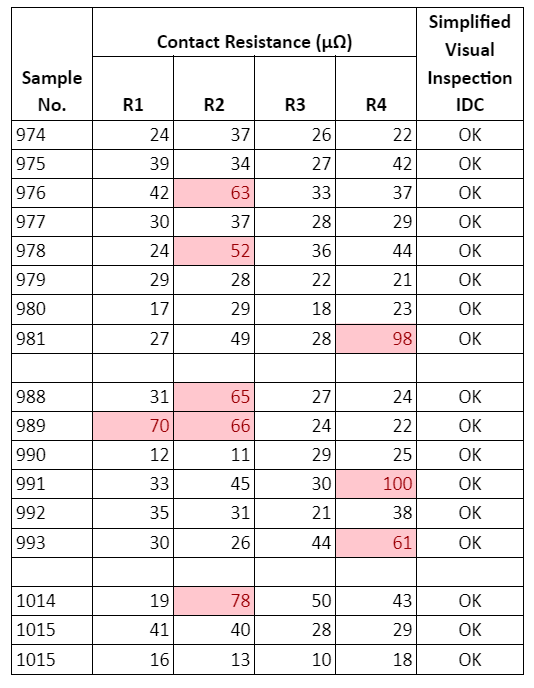Three Applications of the 1750 Micro-Ohmmeter
投稿 4月 04, 2023 によって Advanced Energy Editor
High Resolution, High Accuracy Resistance Measurements Help 3 Volume Parts Makers Meet Tight Quality Standards
High volume parts and component manufacturers serving the automotive and electronics industries must meet rigorous quality standards. A product failure for either industry could prove to be disastrous for both the component or parts vendor and their customers. In these examples, the parts or component manufacturers conducted R&D QA testing as part of their micro-ohmmeter resistance testing evaluations. As the R&D/QA Lab test data is further developed and analyzed, the test procedure will likely become automated. This would ensure that every part would be checked during the production process. In all three examples, the companies evaluated an Advanced Energy's TEGAM 1750 micro-ohmmeter.Case Example #1: A prominent German automotive components supplier with plants in China needed to conduct resistance testing on parts to establish a PASS/FAIL standard. In the production process, a graphite coating is applied to the part since graphite coatings withstand very high temperatures. The coatings also exhibit excellent hydrophobic qualities and thus resist corrosion. The quality test ensures that the part remains conductive after coating. It also provides a control for production costs by identifying parts that have received too little or too much coating.
To generate initial performance parameters, the company tested resistance across the length, width, and thickness of the rectangular shaped component. They measured the resistance across three different distances, 10mm, 8mm, and 5 mm. The initial tests were conducted as an offline QA inspection on approximately 5% of parts produced each hour. The data captured during testing provided the criteria to establish PASS/FAIL limits. Typical measurements were between 50-700 micro-ohms (µΩ), depending on measurement points and probe separation distance. Average deviation between parts, at a given measurement point, was usually below 20 µΩ. This demonstrated that a consistent coating was being applied. Parts outside the average deviation were designated for either scrap (deviation above) or rework (deviation below). The test continuously monitored the process to ensure consistent coatings, thus eliminating the potential for shipping out of spec parts while also optimizing costs. By using non-destructive resistance testing with a micro-ohmmeter, the manufacturer could control and maintain consistency of the coatings without overapplying it.
The quality team at the manufacturer tested multiple micro-ohmmeters from various manufacturers. In the final analysis, the company selected the AE TEGAM 1750 because of its 100 nano-ohm resolution and high accuracy at 0.02% of the reading.
Case Example #2: The same prominent German automotive components supplier in China needed to meet quality standards for an onboard accessory motor component. The quality test ensured that the motor windings achieved the desired conductivity to reduce the risk of motor failure while the vehicle is in operation. The engineering team had originally attempted to evaluate each motor’s quality and performance using a digital multimeter (DMM). However, they found that typical DMMs do not have sufficiently low resolution to meet the requirements for this application. Using a 100 milli-amp test current, they checked resistance at four (4) different points. They established that resistance readings needed to be below 50 micro-ohms to Pass, otherwise, the part failed as shown in the following diagram.

They tested 3-5% of parts produced per hour. This production team also selected the Advanced Energy TEGAM 1750 micro-ohmmeter.
Case Example #3: A China-based manufacturer of electronic components and power supplies needed to test the conductivity of the contacts on a 4-channel relay. Using a 100 milliamp test current and a 2 milli-ohm (mΩ) measurement range, they measured the resistance of each channel. To earn a PASS rating, a part needed to measure below 0.3mΩ. The random testing captured data on approximately 10% of parts produced to identify faulty parts.
The company found that they were able to identify faulty parts because the AE TEGAM 1750 micro-ohmmeter delivered much more accurate readings. The inspection team had previously conducted inspections with a digital multimeter paired with a source meter. The R&D quality team found that the measurement results with a DMM were often 25-50% less accurate and showed much lower repeatability.
Conclusion
For these three competitive R&D quality evaluations, all three factories selected the Advanced Energy TEGAM 1750 micro-ohmmeter. Widely recognized as the instrumentation industry’s fastest precision micro-ohmmeter, the model 1750 provides unmatched precision and speed. This results in immediate improvement in process yields, so much so that the 1750 often pays for itself within a matter of weeks. Automotive and electronic component parts vendors use it to meet stringent quality requirements for component coatings and electrical connections in sub-assemblies.
TEGAM’s 1750 micro-ohmmeter employs multiple techniques to achieve its impressive accuracy. A four-wire kelvin technique eliminates the effects of lead resistance while offset compensation removes the errors caused by thermal contact voltages. The 1750 even monitors its performance over time and adjusts its calibration against a set of internal low temperature coefficient resistors in order to ensure consistent measurement performance without constant recalibration.
Advanced Energy Editor
Advanced Energy
